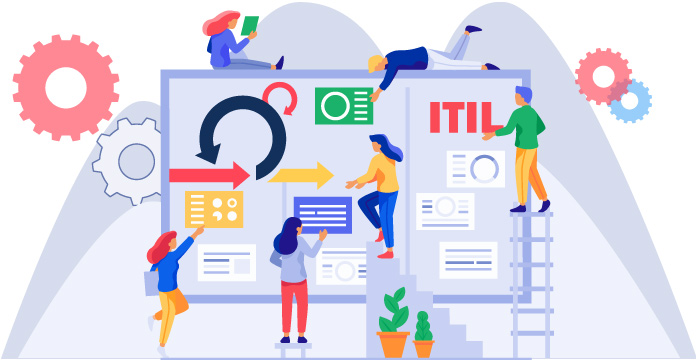
In today’s competitive workplace, several enterprises are into business transformation using ITIL and other industry oriented frameworks for IT Service Management. Their main focus is on improving service quality. Besides quality, organizations are trying to develop agility with the advent of new methodology such as Agile Software Development.
Despite using these methodologies to speed up the delivery process, organizations were not able to manage the delivery rate of IT services. So, industries came up with the concept of integrating ITIL and Agile.
Integrating ITIL and Agile
Prior to knowing the benefits of combining Agile and ITIL; it would be appropriate to describe the overview of each:
ITIL-
In the present technically advanced world, ITIL being a comprehensive framework for ITSM Certification Courses covers concepts like service strategy, service design, service transition, service operation, and continuous improvement.
ITIL is the best practice framework for ITSM from the business/customer perspective, as it focuses on continuous measurement and improvement in IT service quality delivered to the customers.
Agile –
In today’s dynamic business environment, Agile can be effectively applied to any business project. It is a set of processes intended for software development for satisfying customer requirements and acquiring solutions via cross-functional teams. So, organizations need to adopt certain key points to achieve Agile mindset.
The key points are as mentioned below:
- Individuals and interactions over tools and processes.
- Acceptance of change than administration of firm plans.
- Working software over comprehensive documentation.
It is also proven that integration of Agile with ITIL best practices can bring varied benefits to several organizations.
Benefits of combining ITIL Best Practices with Agile
A combined ITSM Certification Courses and Agile approach provide added value to the entire IT delivery service and also helps to define the process.
Three key benefits of integrating Agile with ITIL are:
1. Enhanced workflow
Service management processes such as incident management and problem management can indicate what is stopping the workflow and avert passing a defect downstream. These two aspects must be solved immediately as it can have a direct impact on the clients. Incidents with lower priority can be accommodated inside the team bandwidth. All incidents need not have to be addressed instantly as this approach demands a mind set change. At times, more value can be delivered to the clients by effective selection and prioritization.
2. Continual learning
Agile methodology recommends allotting time for signs of progress in day-to-day activities and in improving resilience. Some of the processes like availability management, information security management, and IT service continuity management help the developers to know what exactly these critical services are and where they have majority risks to focus on.
3. Graceful transition
Agile Scrum Master (ASM) indicates that Agile and ITIL can work together to provide an ideal development environment. It merely requires a thorough understanding of both the methodologies and its strengths.
Where do ITIL and Agile approaches converge?
Despite various approaches, ITIL and Agile converge on various similar aspects. Listed below are few amongst them:
- Focus on bringing results to provide added values to service delivery.
- Giving prominence to ideas that not only allows you to execute processes but also work around the client.
Prior to combining ITIL and Agile, it’s recommended to have a comprehensive knowledge, perspectives, and characteristics of both the methodologies. This will easily allow you to locate the points where these methodologies converge.
These two methodologies can integrate according to their respective business nature; that is why before combining Agile and ITIL, it is recommended to carry out an in-depth analysis of perspectives and characteristics of both the methodologies. This will help you easily locate where these methodologies can integrate.
Thus, by adopting an Agile approach, one can easily adapt to ITIL to accomplish efficient integration.
Listed below are some of the ITIL and Agile processes that organizations can integrate in the best possible way:
- Business Relationship Management
Through this process, ITIL is capable of interacting with the IT service provider as well as the business world to facilitate conformity with the Agile principles with relate to business requirements and on-going business communication.
- Service Level Management
Considering from ITIL point of view, the process provides a comprehensive understanding of the initial requirements of the companies. Later, Agile assists in prioritizing the requirements. The concept of service level management complements business relationship management relating to non-functional requirements.
- Implementation Management
Implementing this process will help the organization to more efficiently manage controls over Agile products for fast, organized, and value-added service delivery.
Conclusion
A combination of Agile and ITIL undoubtedly benefit organizations of all categories, as it enables fast and efficient delivery. It is not demanding to approach ITIL having Agile mind set. Though, ITIL is known for being complex and rigid yet suitable for accustomed implementation. Every aspect of ITIL has always been implemented as per organization requirements. The way you implement ITIL could be very much similar to Agile and benefit the companies to organize fast changes introduced by Agile.
It’s widely known fact that customer requirements vary throughout the lifecycle; both possess in-built processes to handle change instead of stopping it from happening.














